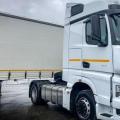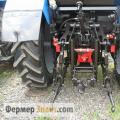All models KavZ 2019: car range KAvZ, prices, photos, wallpapers, technical characteristics, modifications and configurations, reviews of KavZ owners, history of the KAvZ brand, review of KavZ models, video test drives, archive of KAvZ models. You will also find here discounts and hot offers from the official dealers of KavZ.
Archive of KAvZ brand models
History of the KAvZ brand / KavZ
The history of the Kurgan Bus Plant actually begins in 1958, when the first bus with a bonneted layout - KavZ 651. It was a model designed on an extended GAZ 51A truck chassis. In total, 508 copies were produced in the first year of production, 1511 in 1959, and 3434 buses left the gates of the plant in 1960. During the first 5 years, KAVZ reaches its design capacity of 5 thousand vehicles per year. By 1967, the plant managed to build about 50 thousand buses. In the same year, a prototype of the service KavZ 685 was produced, which was based on the GAZ 53 chassis. But the mass production of the model began only in 1971 after lengthy tests.
In 1983, KavZ mastered the production of modernized buses of model 685M, built on the platform GAZ 53-12-1040. Externally, the model almost completely repeated its predecessor, but since 1984, the trapezoidal grille has been replaced by a recognizable rectangular shape. This, in fact, became the most serious difference between the updated KavZ 685M from the previously produced 685 model. In 1986, modernized buses were released, which received the identifier 3270. A distinctive external feature of KavZ 3270 is the characteristic roof transition in the windshield area, where the wiper mechanisms were installed, as well as an information plate with route data. In addition, the rear-view mirror brackets have undergone changes, and 2 air vents have appeared on the roof. In 1989, a new model 3976 began to be produced at the plant in Kurgan.
In the 1990s, a decline in production began at KAVZ. After bankruptcy in 2003, the plant was bought out by the RusPromAvto holding, which in 2005 became part of the GAZ group of companies. The history of KavZ buses, which used the truck chassis of the Gorky Automobile Plant, ended in 2007 with the removal of model 3976 from the assembly line. As of 2009, the modern model range of KavZ consists of rear-engined medium-sized buses of the Aurora family for suburban and inter-district communication, radically different in design from their predecessors. In 2014, the plant started production of updated environmentally friendly models KAVZ-4238 CNG and KAVZ-4270 CNG, running on gas. Currently, the company produces buses for operation on urban, suburban and intercity routes. KavZ became the first plant to develop a school bus that meets all state standards.
In the Urals District, there are many complexes of various types. Not the last place in the list of industries is occupied by mechanical engineering enterprises, in particular, automobile plants. The auto complex of this direction in the region operates several; one of the most famous among them is the Kurgan bus plant "KavZ".
This enterprise, a member of the GAZ Group, has been operating since 1958. A year earlier, an order was received to form a production of buses in Kurgan. Thus, the production of the PAZ-61 model was transferred from the Pavlovsk Automobile Plant. From that time until 2007, small-capacity passenger bonneted vehicles on the GAZ chassis were produced at the Kurgan bus complex.
In 2007, the production of bonnet buses was discontinued; the decision was made in connection with the transition of the enterprise to a new level. So the Kurgan Bus Plant (KavZ) began to produce low-floor mid-size models for intercity passenger transportation. Currently, the auto complex is working in the production of buses from 8 to 10 meters in length for urban, intercity and suburban passenger transportation.
Kurgan Bus Plant, whose website can be found on the Internet, is currently a powerful industrial complex, constantly expanding its product range. The models produced by the Kurgan bus complex are supplied not only to cities in Russia, but also to foreign countries.
Kurgan bus plant "KavZ": products
Currently, the product range of the KavZ enterprise consists of the following types of products:

- small class models based on GAZ chassis;
- small class variants based on the ZIL chassis;
- middle class buses.
One of the core activities of the KavZ enterprise is the production of school buses. The enterprise became the first complex in Russia to develop a bus for transporting schoolchildren in accordance with all GOST standards.
Historical reference
The enterprise OJSC "Kurgan Bus Plant" was founded on January 14, 1958, located in the city of Kurgan. At present, KAVZ LLC is part of the RusAvtobusProm machine-building holding. In the course of its history, the Kurgan Automobile Plant has gradually increased its capacities, expanded the range of its bus models and established branches of its subsidiaries. So, in 1992 the company AK KAVZ, LLC Vika was founded.
Specialization
Small and large buses.
The lineup
The KavZ - 4238 Aurora family of buses for intercity and urban use is equipped with a 210 hp diesel engine of the Cummins type. The bus capacity is 39/41 seats.

The KavZ-397620 family of suburban buses with high cross-country ability on unpaved roads is equipped with a 4.2-liter ZMZ-513.10 eight-cylinder diesel engine with a capacity of 125 hp. The special-purpose bus for transportation of schoolchildren KavZ-397653 "Shkolny" has a capacity of 22 passenger seats, is equipped with a gasoline engine of the ZMZ-513.10 type with a capacity of 130 hp.

The Kavz-324410 half-hood bus model is implemented on the ZIL-5301EO chassis. The model is used as a fixed-route taxi on city and suburban lines. Power equipment: four-cylinder diesel engine MMZ, D-245. 12C, 180 hp and a volume of 4.75 liters.

The KAVZ model based on the GAZ-3310 Valdai chassis is also considered a novelty in the production range of KAVZ. This middle-class bus has 24 seats and is equipped with an economical four-cylinder diesel engine MMZ D-24.7 with a capacity of 90 hp.

Modern stage
The results of technical and engineering developments, many times noted at all-Russian exhibitions, are widely used in the design of KAVZ buses and make these models an example of high-quality, reliable and, most importantly, affordable equipment. The management of the automobile plant considers a promising direction to be the technological improvement of existing buses and the development of new medium-capacity buses "Aurora", the development of which was started in 2002.
Dealers of KAVZ
You can purchase the products of the Kurgan Automobile Plant from the official dealer of the manufacturer - the Autobau company. The company is always ready to offer new models in the required quantity. Sale of KAVZ buses is possible on lease and credit with loyal repayment schemes.
Autobau offers not only favorable dealer prices for products, but also a full range of technical and service maintenance of the supplied equipment. The proposed conditions allow us to flexibly approach any customer needs, build a mutually beneficial relationship scheme and establish long-term cooperation.
Kurgan Bus Plant LLC was once the world's largest manufacturer of small-class bonnet buses. Today the enterprise, after a series of reorganizations and modernizations, specializes in the production of cabover suburban, intercity and urban middle class models. An important area of \u200b\u200bactivity is the assembly of school buses that meet strict safety standards.
Start
In 1953, the construction of a machine-building enterprise began in Kurgan, where it was planned to manufacture military equipment and equipment. However, later the authorities considered that the production of public transport was a more important task for the country at this stage. After changing the profile of its activities, the organization was renamed Kurgan Bus Plant (KAVZ).
09/19/1958, the company was instructed to organize the assembly of buses. The development was taken as the base model, which, in turn, was based on the extended chassis of the GAZ-51 truck. Modification of KAVZ-651 was carried out until 1971 in various designs.
Easy to maintain and repair, reliable, with good cross-country ability, these buses-workers are widely used. Although vehicles were mainly intended for villages, enterprises, shift workers and various organizations, they became common guests on the streets of small towns and megalopolises as public transport.

KAVZ-865
In 1971, the "old man" KAVZ-651 on the conveyor of the Kurgan Bus Plant was replaced by a new 21-seat model - KAVZ-865. It was based on the more advanced chassis of the Gorky Automobile Plant GAZ-53-40. It differed from its predecessor in a more spacious interior, improved design, increased traction, reliability and an increase in the interval between repairs.
These buses can still be found on the roads of the country. Four-ton workers are capable of accelerating to 90 km / h, but the recommended speed is 60 km / h. A significant drawback is the high fuel consumption (24 liters per 100 km). Among the obvious advantages is the heated interior, equipped with soft comfortable passenger seats.
In 1975 the bus was restyled. Apart from minor technical changes, the appearance has changed slightly. In particular, the round rear brake lights and lights have been replaced with rectangular ones. The model turned out to be very successful: in 1975 it was awarded the "Quality Mark". Later (in 1986) improved modifications were named KAVZ-3270.
Achievements
For the Kurgan Bus Plant KAVZ-865 turned out to be a landmark. The bus of this brand has become the most massive in the history of the world automotive industry. The enterprise produced tens of thousands of units annually. 1989 turned out to be a record - this year the plant workers supplied the country with 20,008 units of equipment.
What is the popularity of the model? First of all, in the unification of the chassis with the GAZ-53-40 trucks. Accordingly, there were no problems with finding and replacing spare parts. An important factor was the high cross-country ability. In this connection, the main buyers were state farms, collective farms, rotational services, state enterprises.

KAVZ-3976
In 1989, the Gorky Automobile Plant changed its lineup. The place of the obsolete GAZ-53 on the conveyor was taken by the GAZ-3307/3309. Accordingly, I had to master a new chassis. In the same year, the plant workers presented a more modern model KAVZ-3976. It was produced for almost 10 years.
The 21-seater bus was equipped with a 120/125-horsepower high-torque engine, corresponding to Euro-2 class. There are various modifications:
- passenger;
- cargo and passenger;
- sanitary;
- rotational;
- paddy wagons;
- hearses.
In market conditions
In 1993, after the reorganization of the enterprise into OJSC "Kurgan Bus Plant", a successor was born - KAVZ-39769. The model is distinguished by an elongated chassis base (from 3.7 to 4.5 meters) and a noticeable increase in seating capacity (from 21 to 28). There is a 32-seat modification of KAVZ-39769, based on a 5.4-meter wheelbase. It became the prototype for the 34-seat school bus. By the way, KAVZ became the first in Russia to receive a license to manufacture specialized school buses.
Unfortunately, the following years were not easy for the company. Earlier, the main buyers of buses were collective and state farms. After their disappearance, the volume of sales decreased significantly. For some time, the plant still produced bonnet models for watches, but in 2007 their production was curtailed.

Revival
By the early 2000s, the financial position of the Kurgan Bus Plant was deplorable. In fact, KAVZ was bankrupt. In 2003, the enterprise came under the management of the GAZ group of companies, which had a beneficial effect on production activities. The plant was modernized, the lineup was updated. Instead of obsolete hood models, the factory workers began to assemble modern cabover middle class buses of the Aurora series.
In 2011, instead of engines that did not meet environmental standards, they began to install Cummins Euro-5 engines. Today, in the context of import substitution, foreign components are being replaced by domestic ones. In particular, new power plants of the Yaroslavl Motor Plant are being tested.
Buses under the KAVZ brand can be found in different parts of Russia and the CIS. They are also eagerly bought in Latin America. Over the years, the enterprise has produced more than 440,000 units of equipment, and its history does not end there.
OJSC "Kurgan Automobile Plant" (™: KavZ) is a Russian bus manufacturer. Part of the GAZ Group. The company is headquartered in Kurgan, Russia.
KavZ activities
The plant was founded in 1958 and traditionally specialized in the production of small buses (from 21 to 30 seats).In the 90s, due to changes in the sectors of the national economy, including agriculture, consumer demand for small buses decreased. It became necessary to produce large-capacity city buses in Russia.
Proceeding from this, KAVZ began to create production facilities for the production of city buses.
In 1994. the plant manufactured 8 large-capacity city buses "Ikarus-260" and 2 extra-large-capacity buses "Ikarus-280". In 1996. according to the results of the international tender, 168 "Ikarusov-283.10" were manufactured for the city of Yekaterinburg.
Currently, KAVZ specializes in the production of medium-capacity buses from 8 to 10 meters long.
The main types of KAVZ products:
- Small class buses on GAZ chassis (KAVZ-3976 and modifications)
- Small class buses on ZIL chassis (KAVZ-3244 and modifications)
- The middle-class buses PAZ-4230 "Aurora".




